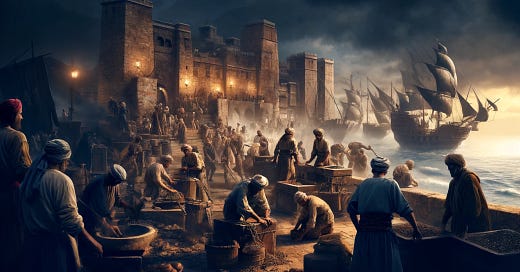The 17th century was a perilous time for mariners across Europe, with piracy and enslavement becoming constant threats on the open seas. Among the most notorious dangers was the Barbary Coast, a stretch of North African coastline infamous for its corsairs. These privateers, often sponsored by local rulers, attacked ships, seized their crews, and sold them into slavery. For many Scottish sailors, including those from the small but strategically vital port of Burntisland, these encounters became harrowing chapters of survival and resilience.
The stories of these captives—detained, ransomed, and sometimes tragically lost—shed light on the challenges faced by maritime communities and the efforts of Scottish society to bring their sailors home.
The Barbary Corsairs: Terror on the High Seas
The Barbary Corsairs operated from ports like Algiers, Tunis, and Tripoli, often preying on European vessels in the Mediterranean and the Atlantic. Armed with swift ships and supported by well-organized networks, they attacked merchant and military vessels alike. Captured crews were typically sold into slavery in North Africa, enduring grueling conditions in quarries, shipyards, or mills. Some were ransomed back to their home countries if their families or communities could raise the money.
For Burntisland’s sailors, voyages to trading ports like Alicante in Spain or even closer destinations such as Ireland carried the constant risk of encountering these corsairs. The plight of one such crew is vividly documented in 1620 when Robert Cowane, captain of the William of Burntisland, and six of his men were captured and sold into slavery in Tétouan, Morocco.
A Grim Reality: Life as a Captive
The conditions endured by captives were brutal. Robert Cowane and his men were forced to labor in a mill, working from dawn until dusk with little sustenance beyond dusty bread and water. At night, they were locked underground in dark, airless quarters, denied even basic bedding. Such experiences were far from unique. Mariners from other Scottish ports faced similar fates, with their accounts painting a grim picture of life under captivity.
These hardships were compounded by the uncertainty of ransom. For many, freedom depended on whether their families, employers, or local communities could raise the necessary funds. The cost of a sailor’s ransom often ran into hundreds or thousands of marks—a significant sum that required collective action to secure.
Burntisland’s Response to Captivity
The community of Burntisland, like many other Scottish towns, rallied to support their captured sailors. The Privy Council records of the time document numerous appeals for financial contributions to ransom captives. In one instance, the Council collected 3,200 marks to secure the release of Cowane and his crew. This sum was gathered from church collections, donations from wealthy merchants, and even contributions from sailors’ families.
The involvement of the church was particularly notable. Sunday collections at the kirk door became a regular practice, with townsfolk donating generously to support their fellow citizens. A poignant example occurred in 1675 when a significant sum was raised for John Kid and other sailors held captive by the “Turks” of Salé, another notorious pirate hub.
Despite these efforts, not all captives were freed. The high cost of ransom meant that some were left to languish in slavery indefinitely, their families unable to gather the required funds. For others, the experience of captivity was a transformative, albeit deeply traumatic, chapter in their lives.
A Broader Context: Piracy and Diplomacy
The issue of piracy and captivity was not limited to Burntisland or even Scotland. Across Europe, governments and private organizations sought to address the scourge of Barbary piracy. Diplomatic efforts often involved negotiations with North African rulers to secure the release of captives or reduce pirate activity. In some cases, treaties were signed, and payments made to guarantee the safety of ships from specific nations.
However, such agreements were often fragile, and piracy persisted well into the 18th century. The ransoming of mariners remained a central concern for many coastal communities, shaping their economic priorities and social structures.
Legacy and Lessons
The tales of Burntisland’s mariners and their struggles against captivity are a testament to the resilience of seafaring communities in the face of extraordinary adversity. These stories remind us of the interconnectedness of the early modern world, where local lives were shaped by global forces, from trade routes to international conflicts.
For Burntisland, the response to such crises also highlighted the strength of community and the importance of collective action. Whether through church collections, civic efforts, or personal sacrifices, the town’s residents came together to support their own.
Today, the stories of these mariners are a part of Scotland’s rich maritime history, offering a window into a time when the seas were as much a source of peril as of promise. The enduring legacy of their struggles underscores the human cost of the open ocean and the resilience required to navigate its dangers.





